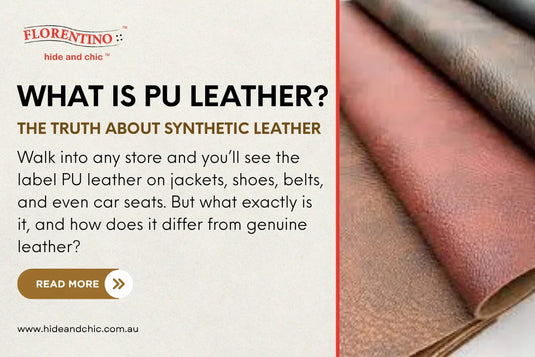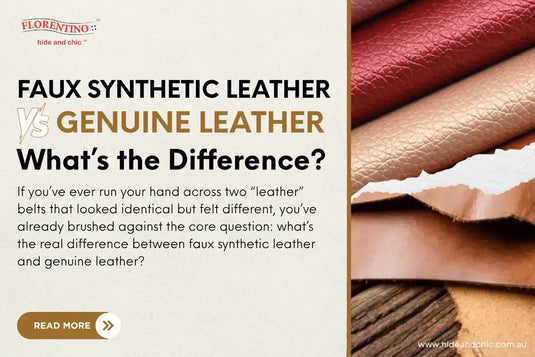Walk into any store and you’ll see the label PU leather on jackets, shoes, belts, and even car seats. But what exactly is it, and how does it differ from genuine leather?
PU (polyurethane) leather is a synthetic leather made by applying a plastic coating to a fabric base—usually polyester or cotton. It mimics the look of real leather but comes with key differences in feel, durability, and longevity.
Understanding those differences helps you make smarter buying choices, especially when investing in accessories meant to last.
What Is Polyurethane Leather?

Polyurethane leather, often shortened to PU leather, is a type of synthetic leather made without any animal hide. It’s created by coating a base fabric, usually cotton or polyester, with a thin layer of polyurethane, a flexible plastic that gives it a smooth, leather-like texture.
Manufacturers can emboss the surface to mimic natural grain patterns or polish it for a glossy finish. The result is a material that looks like genuine leather but feels lighter, thinner, and more uniform.
PU leather became popular because it’s affordable, easy to clean, and cruelty-free. However, unlike natural leather, it doesn’t breathe well, can crack or peel over time, and lacks the depth and patina that make real leather age beautifully.
In short, polyurethane leather is ideal for short-term fashion or décor items, while genuine full-grain leather remains the go-to choice for long-lasting quality and craftsmanship.
The History of PU Leather
PU leather emerged in the mid-20th century as a cost-effective alternative to natural hides. By the 1960s, polymer innovations made it possible to create polyurethane coatings that looked and felt like real leather.
Through the 1970s and 1980s, the fashion and automotive industries embraced PU leather for its affordability and versatility; later aligning with the rise of vegan and cruelty-free trends.
Today, it remains common in footwear and upholstery, though growing focus on sustainability is drawing many buyers back to long-lasting, biodegradable full-grain leather.
How PU Leather Is Made

The process begins with a base fabric coated with a layer of polyurethane. This gives the material a smooth surface and a leather-like finish. Unlike bonded leather, PU doesn’t contain animal hide at all; it's 100% artificial.
Manufacturers can emboss the surface to imitate grain patterns or polish it to a glossy sheen. The result is a flexible, lightweight material that looks good initially but ages differently from natural leather.
PU Leather vs. Genuine Leather
At first glance, PU leather and genuine leather can look almost identical — both polished, sleek, and durable on the surface. But what lies beneath makes all the difference. Their origin, texture, breathability, and lifespan vary drastically, shaping how each material ages and performs over time
Here’s a straightforward comparison to help you understand how synthetic leather vs real leather truly stack up:
|
Feature |
PU (Synthetic) Leather |
Genuine Leather |
|
Material Source |
Plastic (polyurethane) over fabric |
Animal hide |
|
Durability |
1–3 years before peeling or cracking |
10–20 years with care |
|
Texture & Feel |
Smooth, uniform, slightly plastic |
Natural, warm, textured |
|
Breathability |
Low; traps heat and moisture |
High; skin-like ventilation |
|
Aging |
Cracks and flakes over time |
Develops a rich patina |
|
Maintenance |
Easy to clean, low-care |
Needs conditioning and protection |
|
Eco Impact |
Petroleum-based, non-biodegradable |
Biodegradable if tanned naturally |
What this means in practice: PU may look sleek out of the box, but genuine leather builds character over the years. For belts, wallets, or pouches that see daily use, synthetic leather vs real leather becomes a question of short-term shine versus long-term strength.
How to Tell if Your Product is Made of Vegan or PU Leather

Spotting vegan leather, also called synthetic leather or PU leather, is easier once you know what to look for. While it can mimic the appearance of real hide, a few simple tests reveal the difference.
-
Check the Label: Most brands clearly mention “PU leather,” “vegan leather,” or “synthetic material.” Genuine leather is usually labeled as “full-grain,” “top-grain,” or “real leather.”
-
Smell Test: Real leather has a rich, earthy scent that’s hard to copy. Vegan leather often smells slightly chemical or plastic due to its polyurethane base.
-
Texture and Grain: Vegan leather feels smoother and more uniform, while real leather shows natural imperfections and subtle grain variation.
-
Backside Material: Flip it over, genuine leather has a rough, suede-like backing; synthetic leather has a woven fabric or foam layer.
-
Water Reaction: A drop of water will slowly absorb into real leather but bead up on synthetic leather’s surface.
These small checks can help you confirm if your new belt, bag, or tobacco pouch is made from vegan leather or the real thing.
The Benefits (and Limits) of PU Leather
✔ Budget-friendly: PU leather costs significantly less than full-grain or top-grain leather, making it appealing for trend-driven fashion.
✔ Vegan option: No animal hides are used, so it’s popular among cruelty-free buyers.
✔ Easy upkeep: Just wipe with a damp cloth—no polishing or conditioning required.
However, there are trade-offs:
-
It’s prone to cracking and peeling, especially in humid weather.
-
It doesn’t breathe like real hide, which can cause heat buildup.
-
Once damaged, it’s nearly impossible to repair.
For products that demand durability, like belts, wallets, or travel pouches, full-grain leather remains the benchmark.
Why Many Brands Use PU Leather
Fast fashion and mass production thrive on materials that are affordable and quick to manufacture. PU fits both. It lets brands offer stylish designs at lower price points.
But at Hide & Chic, our philosophy is different. We focus on sustainability, craftsmanship, and longevity, using ethically sourced full-grain hides rather than synthetics. Real leather lasts decades; synthetic alternatives often don’t survive more than a few seasons.
The Bottom Line: PU Leather Has Its Place
PU leather is practical for short-term fashion and vegan products. But for heirloom-quality belts or everyday accessories, genuine leather stands far ahead in texture, strength, and character.
When comparing synthetic leather vs real leather, think about lifespan. A full-grain leather belt may cost more upfront, but it will outlast several PU versions—making it the smarter investment in the long run.
Experience Real Leather With Hide & Chic
Discover a curated range of premium accessories made to last:
-
Buy leather belts that age beautifully and stay timeless.
-
Buy tobacco pouch designs crafted from supple full-grain leather.
-
Explore wallets and travel accessories built for endurance and elegance.
Every piece from Hide & Chic is handmade using ethically sourced hides and eco-friendly tanning methods, proof that true quality never goes out of style.
FAQs About PU Leather and Vegan Materials
1. Is PU leather the same as vegan leather?
Not always, but often. Most vegan leather is made from polyurethane (PU) or polyvinyl chloride (PVC), both of which are synthetic materials that contain no animal hide.
2. Does PU leather last as long as real leather?
No. PU leather generally lasts 1–3 years before showing cracks or peeling, while genuine full-grain leather can last decades with care.
3. How can I tell if a product is made from PU leather?
Check the tag or description. It will usually say PU leather, synthetic leather, or vegan material. The surface will feel smooth and even, unlike the natural texture of real hide.
4. Is PU leather waterproof?
It’s water-resistant, not waterproof. It repels small spills but can still absorb moisture over time, leading to peeling or warping.
5. Is PU leather environmentally friendly?
PU leather avoids animal use, but it’s plastic-based and not biodegradable. Ethically sourced, genuine leather, especially vegetable-tanned, is often more sustainable long-term.
6. What’s better for belts and pouches — PU or real leather?
For short-term fashion use, PU leather works fine. But for daily wear items like leather belts or tobacco pouches, genuine full-grain leather is far more durable and develops character with age.





